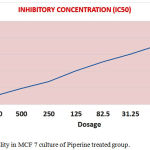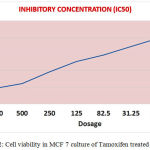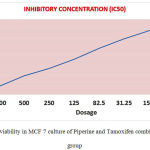Manuscript accepted on :27-Sep-2018
Published online on: 08-10-2018
Plagiarism Check: Yes
Reviewed by: Thoudam Debraj Singh
Second Review by: Wajana Lako
Thulasi Gokul , Anusha D
, Anusha D and Darling Chellathai David
and Darling Chellathai David
Department of Pharmacology, Sri Ramachandra Medical College and Research Institute, Porur, 600116, Chennai, India.
Corresponding Author E-mail: drdanusha@gmail.com
DOI : https://dx.doi.org/10.13005/bpj/1568
Abstract
This breast cancer is the one which is common in people across the country with mortality incidence ratio of 66 in rural and 8 in urban according to statistics in India. Breast cancer can be cured once it is diagnosed appropriately and when treatment is started at right time with right drug in proper dosage. But chemotherapy itself have many adverse events, to come over these problems, we can always have a help of natural products in hand like Piperine for the safety in future. To evaluate Anti-Cancer activity of Piperine and Tamoxifen and in both as Combination on the MCF 7 human breast cancer cell lines. Breast cancer cells (MCF) have been treated with piperine and incubated at 37 c, the drug samples are added and incubated for 3 hours then followed by MTT dye is added and incubated.1 ml of dimethyl sulfoxide is added and incubated. Absorbance at 537nm was measured with UV spectrophotometer using DMSO as the blank. Then IC50 was determined in graphical representation according to percentage of cell viability and concentration of sample. The anti-cancer effect of Piperine and Tamoxifen and in Combination, when treated with MCF 7 human breast cancer cell lines, starting from minimum to maximum dose concentration (μg/ml), the percentage of cell viability is 51.49 at the dose of 62.5 μg/ml, 51.09 at 125 μg/ml, 52 at the dose of 32.5 for Piperine, tamoxifen and combination respectively. From this study, the drug Piperine on combining with Tamoxifen have significant anti-cancer activity, which would probably play a role as cytotoxic agent in tumour cells.
Keywords
Breast Cancer; Cytotoxic Activity; Oestrogen Receptor Antagonist
Download this article as:| Copy the following to cite this article: Gokul T, Anusha D, David D. C. A Comparative Study on Viability of Mcf-7 Human Breast Cancer Cell Lines Using Piperine and Tamoxifen – An In Vitro Study with A Novel Mishmash. Biomed Pharmacol J 2018;11(4). |
| Copy the following to cite this URL: Gokul T, Anusha D, David D. C. A Comparative Study on Viability of Mcf-7 Human Breast Cancer Cell Lines Using Piperine and Tamoxifen – An In Vitro Study with A Novel Mishmash. Biomed Pharmacol J 2018;11(4). Available from: http://biomedpharmajournal.org/?p=23511 |
Introduction
Cancer is the primary cause of death in globe and in India as well. Though there are many types of cancers in world, out of all these Breast cancer has occupied top position in an Indian society. This breast cancer is the one which is attractive in people across the country with mortality incidence ratio of 66 in rural and 8 in urban according to recent statistics In India. Breast cancer can be cured once it is diagnosed appropriately and when treatment is started at right time with right drug in proper dosage. Since there are many adverse effects in cancer chemotherapy this should be addressed in an intense way with the help of combination of drugs and so we can prevent resistance, can increase the bioavailability of the drug, decreasing the adverse effects of the present drug in chemotherapy. Approximately 70 % of breast cancers are Estrogen Receptor Positive or Endocrine Sensitive type, as Tamoxifen is an Estrogen Receptor Antagonist is prescribed at 20 mg/kg/day dosage for the treatment of endocrine sensitive breast cancer. There is a footnote in the same study saying that tamoxifen in combination with GnRH Agonist in Estrogen receptor positive is as effective as Cyclophosphamide, Methotrexate and 5 Fluorouracil (CMF Regimen) and hence this may be used as alternate therapy. According to ATAC trial the one robust suggestion is the tamoxifen can also prevent the contra lateral breast cancer. This is how the breast Tamoxifen have created its own importance in the treatment of breast cancer. Now as we all know by combination of the drug is very compliant in treating the disease, but nowhere we are in lack of taking help of natural products in treating the disease for a better upshot. Centuries old plants have always been an integral part of treating various types of cancers though allopathy medicines have been the mainstay of treatment. However numerous studies have quoted the effects of Piperine on various types of carcinomas, by increasing bioavailability and reducing adverse effects of the prescribed therapeutic drug.1 Piperine treatment alone has shown beneficial effects in breast carcinoma targeting cancer stem cell renewal properties.2 Piperine was reported to inhibit p-glycoprotein which is a potential inhibitor of tamoxifen.3 We hypothesise that this combination of tamoxifen with piperine extract would show beneficial effect therapeutically in breast cancer cell lines.MCF-7 cell line was developed by Herbert D. Soule from an excision of chest wall nodules and pleural effusion on his seventh attempt at Michigan Cancer Foundation, hence the name MCF-7.4 This excision was collected from a patient Helen Marion who was suffering from metastatic disease, and developed MCF-7 cell line.5 This study explores the cytotoxic effects of Piperine and tamoxifen amalgamation against MCF 7-human breast carcinoma cell lines.
Materials and Methods
Michigan Cancer Foundation-7 cell line (Human Breast Cancer Cell lines) was purchased from National centre for cell sciences Pune (NCCS). The cells were cultured in MEM (Minimal Essential Medium). The MEM culture medium consisted 10% Fetal Bovine serum (FBS), Streptomycin (100 μg/ml), Penicillin (100 U/ml) with a well maintained humidified atmosphere and temperature (50 μg/ml CO2, 37 °C). Media and chemicals were obtained from Hi Media Laboratories (Reagents, MEM), Cistron laboratories (Fetal Bovine Serum), Sisco research laboratory chemicals Mumbai (Trypsin, methylthiazolyl diphenyl- tetrazolium bromide and Dimethyl sulfoxide), Sigma Aldrich Mumbai (Piperine and other chemicals, reagents).
MTT Assay
As described previously,6 assay have been performed and it’s done accordingly. Initially in the 24 well plate cells were plated and at the temperature of 370 c with5% Co2 these cells are incubated in an aseptic conditions. When these cells reach to the stage of confluence, in different concentrations samples were added and incubated for next 1 day or 24 hours of duration. Once the process of incubation is done, the sample are removed from the well and cleaned or washed with saline that is Phosphate buffered with PH 7.4. In each well, 100 μl of 0.5% 3(4, 5- dimethyl – 2-thiazolyl)-2, 5-diphenyl- tetrazolium bromide (MTT) was supplemented and then for the next 4 hours samples are incubated.
Once the incubation is done, DMSO added in all the wells. Absorbance at 570 nm using ultraviolet visible spectrophotometer, measure taking the DMSO as blank. The performed measurements done using UV- Spectrophotometer, were calculated the Inhibitory concentration (IC50) and determined graphically. The concentration required to show the 50% of inhibition is known as Inhibitory Concentration, this IC 50 value is calculated with the measurements that are performed already. The percentage of cell viability is determined using the principle, Percentage of cell viability equals to absorbance at 570 nm of treated cells by absorbance at 570 of control cells cross 100.
Results
The Anticancer effect of Piperine, Tamoxifen and their Combination, when treated on MCF 7 cell lines starting from minimum to maximum dose concentration (µg/ml), the Percentage of cell viability is shown in Table 1.
Table 1: Anti cancer effects of Piperine, Tamoxifen and Piperine+Tamoxifen combination.
| S.No | Dose (µg/ml) | Piperine | Tamoxifen | Combination |
| 1 | Control | 100 | 100 | 100 |
| 2 | 7.8 | 78.92 | 84.69 | 66.06 |
| 3 | 15.6 | 70.97 | 78.92 | 59.43 |
| 4 | 31.2 | 60.43 | 69.18 | 52.00 |
| 5 | 62.5 | 51.49 | 58.84 | 42.97 |
| 6 | 125 | 40.55 | 51.09 | 32.73 |
| 7 | 250 | 27.03 | 38.56 | 24.29 |
| 8 | 500 | 19.48 | 24.85 | 17.26 |
| 9 | 1000 | 10.13 | 18.68 | 7.63 |
The percentage of maximum cell viability of Piperine is 78.92% (minimum cell inhibition- 21.08%) observed at 7.8µg/ml whereas minimum cell viability of Piperine is 10.13%(maximum cell inhibition -89.87%) observed at 1000µg/ml, In Tamoxifen maximum cell viability is 84.86%(minimum cell inhibition –15.31%) and minimum cell viability for the same is 18.68%(maximum cell inhibition -81.32) whereas in combination of Tamoxifen and Piperine maximum cell viability is 66.06%(minimum cell inhibition – 33.94) and minimum cell viability is 7.63 (maximum cell inhibition – 93.47%) at minimum concentration of 7.8%µg/ml and maximum concentration of 1000µg/ml respectively. The IC50 value is plotted accordingly in graph and depicted in Figure 1-3.
 |
Figure 1: Cell viability in MCF 7 culture of Piperine treated group.
|
 |
Figure 2: Cell viability in MCF 7 culture of Tamoxifen treated group.
|
 |
Figure 3: Cell viability in MCF 7 culture of Piperine and Tamoxifen combination treated group.
|
Discussion
Our data indicate that piperine might increase tamoxifen efficacy by interacting with P-glycoprotein. Recent studies suggest tamoxifen as directly acting drug in treatment of breast cancer and found beneficial with good efficacy, tolerability and oral bioavailability.7-9 P-glycoprotein was reported to limit the concentration of active metabolites of tamoxifen in breast cancer cells causing a compromise in the treatment. This was thought to be a clinical implication for acquired or innate resistance to tamoxifen treatment by breast cancers. In untreated breast cancer cells, approximately 40% of P-glycoprotein expression was reported and this was increased with initiation of chemotherapy which decreased response to treatment.10,11 Many drugs decreasing drug resistance showed specific and competitive (with cytotoxic drugs) binding to P-glycoprotein for active transportation.12-14 Many P-glycoprotein inhibitors are in clinical trials and many failed due to unfavourable drug properties and toxicity.15-21 Piperine showed satisfactory drug properties and inhibition of P-glycoprotein efflux activity. Piperine reversed drug resistance of KB and SW480 cancer cell lines to chemotherapy.22 In our study Piperine combination showed maximum therapeutic effect in comparison to individual drug treatments.
Conclusion
From the study, we conclude that combination of Piperine and Tamoxifen shows, enhanced cell Inhibitory activity on growth of MCF 7 human breast cancer cell line, on comparing with individual Inhibitory activity of Piperine and Tamoxifen. This combination can be taken as novel drug combination aiding to treat breast carcinoma. Further studies are required to prove other effects of this combination
Conflicts of Interest
There is no conflicts of interest.
Acknowledgements
I acknowledge Dr. P. Elango, Professor, Department of Pharmacology, SRMC & RI-DU and Dr.Sharanya and Dr. Jyothsna Pinni for providing their expertise support during the study.
Funding Source
There is no funding source.
References
- Singh D. V., Godbole M. M & Misra K. A plausible explanation for enhanced bioavailability of P-gp substrates in presence of piperine: simulation for next generation of P-gp inhibitors. J Mol Model. 2013;19:227.
CrossRef - Truong M. D., Gyun H. K., Ho J. C., Khanal T., Hwan B. P., Phuong T. T., Cheon T. J., Gwang H. J. Antitumor efficacy of piperine in the treatment of human HER2-overexpressing breast cancer cells. Food Chemistry. 2013;141(3):2591-2599.
CrossRef - Bhardwaj R. K., Glaeser H., Becquemont L., Klotz U., Gupta S. K., Fromm M. F. Piperine, a major constituent of black pepper, inhibits human P-glycoprotein and CYP3 A4. J Pharmacol Exp Ther. 2002;302:645-650.
CrossRef - Soule H. D., Vazguez J., Long A., Albert S., Brennan M. A human cell line from a pleural effusion derived from a breast carcinoma. J Natl Cancer Inst. 1973;51(5):1409–1416.
CrossRef - Immaculate Heart of Mary Convent. Archive Notes. 2013;4(2). http://ihmsisters.org/wp-content/uploads/2013/06/_June_Archives Notes. pdf.
- Mosmann T. Rapid colorimetric assay for cellular growth and survival: application to proliferation and cytotoxicity assays. lmmun. Meth.1983;65:55-63.
CrossRef - Fisher B., Constantino J. P., Wickerham C. D., Redmond C. k., Kavanah M., Cronin W. M., Vogel V., Robidoux A., Dimitrov N., Atkins J., Wieand S., Tan-Chiu .E, Ford L., Wolmark N. Tamoxifen for prevention of breast cancer: report of the National Surgical Adjuvant Breast and Bowel Project P-1 study. J Natl Cancer Inst. 1998;90:1371–1388.
CrossRef - McKeon V. A. The breast cancer prevention trial: should women at high risk take tamoxifen? J Obstet Gynecol Neonatal Nurs. 1999;28:34–38.
- Radmacher M. D., Simon R. Estimation of tamoxifens’s efficiency for preventing the formation and growth of breast tumors. J Natl Cancer Inst. 2000;92:48–53.
CrossRef - Clarke R., Leonessa F and Trock B. Multi drug resistance/P-glycoprotein and breast cancer review and meta-analysis. Semin Oncol. 2005;32(Suppl 7):S9–S15.
CrossRef - Leonessa F and Clarke R. ATP binding cassette transporters and drug resistance in breast cancer. Endocr Relat Cancer. 2003;10:43–73.
CrossRef - Cornwell M. M., Pastan I and Gottesman M. M. Certain calcium channel blockers bind specifically to multidrug resistant Human KB carcinoma membrane vesicles and inhibit drug binding to P-glycoprotein. Biol. Chem. 1987;262:2166-2170.
- Safa A. R., Glover C. J., Sewell J. I., Meyers M. B. Biedler J. I and Felsted R. Identification of the multidrug resistance related membrane glycoprotein as an acceptor for calcium channel blockers. Biol. Chem. 1987;262:7844-7888.
- Ryffel B., Woerly G., Rodriguez C and Foxwell B. M. J. Identification of the multidrug resistance-related membrane glycoprotein as an acceptor for cyclosporin. Rec. Res. 1991;11:675-686.
- Khaleel S. A., Al-Abd A. M., Ali A. A & Abdel-Naim A. B. Didox and resveratrol sensitize colorectal cancer cells to doxorubicin via activating apoptosis and ameliorating P-glycoprotein activity. Sci Rep. 2016;6:36855.
CrossRef - Qiu Q. et al. Design Synthesis and Pharmacological Characterization of N-(4-(2 (6,7-Dimethoxy-3,4-dihydroisoquinolin-2(1H)yl)ethyl)phenyl)quinazolin-4-amine Derivatives Novel Inhibitors Reversing P-Glycoprotein-Mediated Multi drug Resistance. J Med Chem. 2017;60:3289–3302.
CrossRef - Xue G. M. et al. neo-Clerodane diterpenoids from Scutellaria barbata mediated inhibition of P-glycoprotein in MCF-7/ADR cells. Eur J Med Chem. 2016;121:238–249.
CrossRef - Dash R. P., Babu J., R & Srinivas N. R. Therapeutic Potential and Utility of Elacridar with Respect to P-glycoprotein Inhibition: An Insight from the Published In Vitro Preclinical and Clinical Studies. Eur J Drug Metab Pharmacokinet. 2017.
CrossRef - Gao Y. et al. Pharma cokinetics and tolerability of NSC 23925b, a novel P-glycoprotein inhibitor preclinical study in mice and rats. Sci Rep. 2016;6:25659.
CrossRef - Zhang C. G. et al. Novel polymer micelle mediated co-delivery of doxorubicin and P-glycoprotein siRNA for reversal of multi drug resistance and synergistic tumor therapy. Sci Rep. 2016;6:23859.
CrossRef - Ma W. et al. Nobiletin enhances the efficacy of chemotherapeutic agents in ABCB1 over expression cancer cells. Sci Rep. 2015;5:18789.
CrossRef - Syed S. B., Arya H., Fu I. H., et al. Targeting P-glycoprotein Investigation of piperine analogs for overcoming drug resistance in cancer. Scientific Reports. 2017;7:7972.
CrossRef







